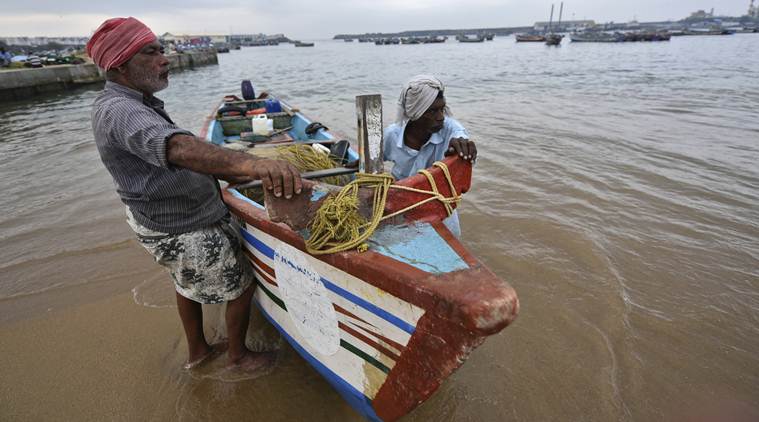Stay updated with the latest - Click here to follow us on Instagram
Cyclone Ockhi alert: Where does the buck stop?
Cyclone Ockhi: While subsequent rescue operations by the Navy, Air Force and the Coast Guard have brought back more than 2,500 fishermen, many are still missing.
 Although it does not blame the state government, a release from the Prime Minister’s Office said the Home Ministry had sent a warning on November 29 to the Kerala Chief Secretary about a ‘possible cyclone.’
Although it does not blame the state government, a release from the Prime Minister’s Office said the Home Ministry had sent a warning on November 29 to the Kerala Chief Secretary about a ‘possible cyclone.’
In coastal villages, seriously affected by Cyclone Ockhi in southern Kerala, the deepest grouse among the locals has been that the warnings for fishermen not to venture into sea never came on time. With 70 people dead in Kerala alone and dozens still missing at sea, they say that had they been warned early, the toll would have been much less. Most of the casualties reported in Kerala are presumed to be those who went fishing in the sea on November 29 (Wednesday) in the small fibre boats. These fishermen, who usually go in the afternoons and come back early the next day, were reportedly struck by the heavy winds and monster waves on the intervening night of Nov. 29-30. While subsequent rescue operations by the Navy, Air Force and the Coast Guard have brought back more than 2,500 fishermen, many are still missing.
With Prime Minister Narendra Modi visiting the cyclone-affected areas in Thiruvananthapuram on Tuesday, the debate about the timing of the cyclone alert has once again been raised. Although it does not blame the state government, a release from the Prime Minister’s Office said the Home Ministry had sent a warning on November 29 to the Kerala Chief Secretary about a ‘possible cyclone.’
Meanwhile, IndianExpress.com checked with the relevant agencies to find out whether there was indeed a late warning about the cyclone.
Indian Meteorological Department (IMD)
Much before it turned into a cyclonic storm and took the name of Ockhi, meteorologists say it had originated near the south-western coast of Sri Lanka as a ‘low-pressure area’ turning quite quickly into a depression. IMD officials say the first bulletin, that went at 11:50 am on Nov 29, cited the depression and warned that sea conditions would be rough with an advisory for fishermen not to go to sea for the next 48 hours. This message was sent to all government authorities and disaster management officials.
“Once the storm becomes a depression, there is a need to be alert and prepared. In the second bulletin, we said the sea conditions would be rough to very rough with wind speeds of 65 km/hr. Fishermen were warned to stay away from the sea,” said VK Mini, a scientist at IMD.
The depression, which converted into a deep depression, is reported to have became a cyclonic storm after it crossed the Comorin area on the morning of November 30, by which time the sea around the southern coasts of Kerala and Tamil Nadu had already turned rough. In the case of Ockhi, there was rapid intensification of the storm from a deep depression into a cyclonic storm, IMD officials say. They maintained that alerts were passed on at the right time as the information was gathered.
According to meteorologists, ideal conditions like availability of moisture and sea surface temperature rising above 26 degree celsius are needed for a depression to acquire the form of a cyclone.
INCOIS
The Indian National Centre for Ocean Information Services (INCOIS), an autonomous body under the Ministry of Earth Sciences, said the first prediction of high ocean waves was made on Nov. 28 and subsequently the information was related to the governments of the two states.
“Once IMD declared a deep depression, we issued a joint bulletin at 2:30 pm on Nov. 29 quoting its characteristics and how ocean waves will behave. We sent this information to all relevant authorities,” said PM Balakrishnan Nair, a scientist at INCOIS.
He said, during a cyclone, its position may be far away, but the waves can become turbulent causing problems especially for fishermen in small boats. He confirmed that waves could have reached 8-9m high during Ockhi.
Nair said the organisation is analysing why the cyclone moved towards the Arabian sea in the direction of Lakshadweep, a region which doesn’t see regular cyclonic formations.
State Disaster Management Authority
In a statement released on December 2, the state disaster management authority rejected reports that it acted late in response to the cyclone. It said that according to the standard operating procedure, it could act only when the disaster is officially classified as a ‘cyclone’. It said it received the official cyclone warning only at 12 noon on November 30. Warnings of huge waves and strong winds could not be seen as a disaster, it said in the statement.
The SDMA said it promptly relayed the information received from IMD after 2:30 pm on November 29 of strong winds and warning for fishermen to the public through its official messaging service.







